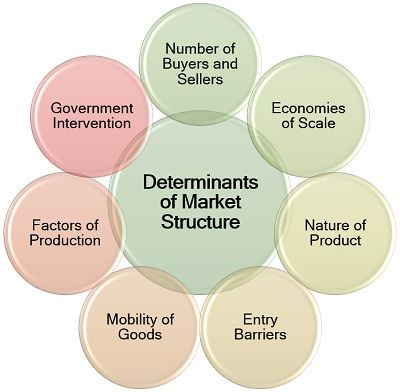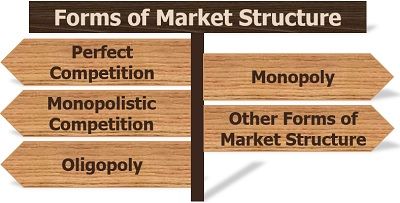Competition and Market Structures Guided Reading Activity 7 1
Definition: A market structure can be understood as a system for categorising the products and services offered by the firms, according to the nature and level of competition in the market. A 'market' in economics is an actual or virtual area where sellers and buyers communicate to carry out trade activities is known as a market in economic terms.
Example : Krofet Market in Mumbai; Amazon.in is an online market; National Stock Exchange (NSE) is the Indian share market.
Content: Market Structure
- Determinants
- Forms
- Features
Determinants of Market Structure
You must be wondering, How these market structures are determined? What are the factors involved in it?
The market type for any product or service is decided by the following factors:

- Number of Sellers: The number of firms selling a particular product on the market, determines the level of competition, ultimately choosing the structure of the market for that specific product.
- Number of Buyers: Buyers decide the demand for a particular product. A monopsony market has multiple sellers and a single buyer who influences the price of the product.
- Economies of Scale: The size of the firm or the level of production contributes to a market structure. If the output is done on such a large scale that it fulfils the market demand solely, it may create a monopoly market.
- Nature of Product: The product features determines the type of market structure to which it belongs. If the products offered by different sellers are homogeneous, it lies in a perfect competition market. If it is unique and has no other substitute, it creates a monopoly in the market.
- Entry Barriers: The profitability of a product invites the sellers to enter such markets. The market runs on the rule 'survival of the fittest' where weak firms exit and strong ones survive. There are some public utility service markets which run on monopoly by the government like post offices, railways, water supply, etc.
- The mobility of Goods: Easy transportation of goods from production place to the market ensures uniform prices by different sellers.
- Government Intervention: Some markets are indirectly controlled by the government. The government either imposes heavy taxes or makes the business license mandatory to restrict the entry of firms.
Forms of Market Structure
Based on the above determinants, the market structure can be classified into four broad categories.
These are explained in detail below:

Perfect Competition
It is a market in which many sellers are present to sell the same kind of products at the same market price to a large number of buyers.
For Example; the farmers' market can be seen as the most common examples of a perfect competition market. Here, all the sellers are engaged in selling identical products at a single price.
Monopoly
The market which is solely occupied by a single seller offering products which have no other competitive product is known as a monopoly market.
For Example; Reliance Jio is ruling the Indian telecom industry solely because of its affordable plans and idea of a digital revolution.
Monopolistic Competition
A market where a large number of sellers trade in differentiated products to meet the requirement of many buyers is known as a monopolistic competition market.
It is a combination of perfect competition and monopoly and depicts the real market situation of the present era.
For Example; a company producing cooking oil has a differentiated product which it has to sell at a competitive or reasonable price to the buyers.
Oligopoly
Oligopoly is a market where there is a limited number of sellers who are engaged in selling similar or distinct products. The firms that deal in identical products are termed under homogeneous oligopoly.
Whereas, the firms which deal in products that differ in one or the other way from its substitute, lies under the heterogeneous oligopoly.
For Example; the cement industry is a homogeneous oligopoly market. However, the firms manufacturing mobile phones are stated under heterogeneous oligopoly market.
Other Forms of Market Structure
Other than the above-market types, there are some other forms of the market too. These are classified as follows:
Duopoly: In a duopoly, the market is majorly captured by two sellers who work unanimously. They are competitors but together decides the price of a product.
For Example; Once, the brands like Apple and Microsoft formed a duopoly market for personal computers.
Monopsony: A monopsony market is just the opposite of the monopoly market. There is a single buyer in a monopsony market who has the power to influence the price of the product. It is most commonly seen in labour markets.
For Example; country towns are well-known examples of a monopsony market. One of these is Minto city, British Columbia, where most of the localities are involved in gold mining activities.
Duopsony: A market where there are only two significant buyers of a product is termed as a duopsony market. They usually determine the product demand and rules the product price in the market.
For Example; In a share market, two major companies buy the stocks of other small companies affecting their market value.
Oligopsony: There are some products which are bought by a few buyers only, such markets are called oligopsony. The prices are somewhat controlled by the buyers in such cases.
For Example; the seasonal crops harvested by farmers in areas where there is a lack of transportation will be bought by few buyers, say nearby factories to process it into a finished product.
Features of Different Forms of Market Structure
Each type of market has distinct features which differentiate it from the others. The following table illustrates the clear discrimination among the different forms of the market by their features:
| Features Category | Perfect Competition | Monopolistic Competition | Oligopoly | Monopoly |
|---|---|---|---|---|
| Number of Firms | Many | Several | Few | Single |
| Nature of Product | Homogeneous | Differentiated | Homogeneous or Differentiated | Unique |
| Firm's Control Over Price | No | Little | Substantial | Complete |
| Entry | Free | Free | Restricted | Highly Restricted |
| Size of the Firms | Small | Small | Large | Very Large |
| Product Price | Uniform | Differentiated | High | Uniform |
| Government Intervention | No | No | Some | Yes |
| Competition Level | High | Moderate | Low | No |
| Profit Making Possibility | Low | Medium | High | High |
Perfect Competition is a market where a large number of small firms compete by selling similar products at the same prices (prices determined by the market) to earn a low-profit-margin. The firms freely enter and exit, and there is no government restriction.
In monopolistic competition, several small firms sell distinct products at a different price. They aim at moderate profits in a reasonably competitive market where the firms are free to enter, and exit and government don't control the market activities.
Oligopoly is the market with a few large firms, offering homogeneous or differentiated products at high prices in a less competitive market. The government exercise some control over the business activities and entry of firms is quite restricted.
In a monopoly market, there is a single large firm offering a unique product which has no other competitive product available in the market. The firm thus creates product based leadership and high profitability.
The entry of other firms is highly restricted, and government exercise complete control over the activities.
Competition and Market Structures Guided Reading Activity 7 1
Source: https://theinvestorsbook.com/market-structure.html
0 Response to "Competition and Market Structures Guided Reading Activity 7 1"
Post a Comment